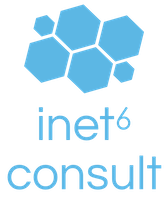At my first job back in 1992 I had three things on my desk: a big phone, a 486SX PC running Windows 3.0 and a DEC VT320 terminal. Even back then those were pretty outdated, but we still used them for our helpdesk ticket system and our in-company email. (By the way, I recommend that everyone in tech starts as a helpdesker.) Five years later, I started a company with four others, and the first business we did was collect a bunch of VT420 terminals, which we then sold for ƒ 25,- a piece. I kept one for myself.
So the Digital VT100 terminal family holds a special place in the retro tech corner of my heart. Over the years, I tried to connect the terminal to my Mac using a USB-to-serial converter a few times, but never got anywhere. Today, I tried again, and finally got everything to work.

Read the article - posted 2020-01-25
We shouldn't gauge the success of IPv6 by looking at how much IPv6 replaces IPv4, but by how much IPv6 complements IPv4. And it's already doing that quite well today by making IPv4aaS (IPv4 as a service) possible. And IPv4aaS will make ISPs require IPv6 when peering with streaming services and other big content providers.
 Permalink
Permalink - posted 2020-01-23
-
🇳🇱 Nederlandse versie
►
A few days ago I ran into this blog post from 2012: Deprecate, Deprecate, Deprecate, which lists a bunch of IPv6 stuff that's been "deprecated" by the IETF. That means: we changed our minds about this protocol or feature, stop using it.
Full article / permalink - posted 2020-01-13
▼
A few days ago I ran into this blog post from 2012: Deprecate, Deprecate, Deprecate, which lists a bunch of IPv6 stuff that's been "deprecated" by the IETF. That means: we changed our minds about this protocol or feature, stop using it.
The list (the blog post obviously has more information):
- IPv4-compatible IPv6 Addresses. Status: Deprecated.
- Site-Local Addresses. Status: Deprecated.
- The 6bone. Status: Deprecated.
- ipv6.exe (Windows XP). Status: Deprecated.
- NAT-PT and NAPT-PT. Status: Deprecated.
- The Type 0 Routing Header. Status: Deprecated.
- Your valid yet older SLAAC IPv6 addresses. Status: Valid (but deprecated).
But what, no IPv6/DNS-related deprecations?
Perhaps the most annoying one of those was the change from ip6.int to ip6.arpa. Originally, the idea was to have reverse mapping of IPv6 addresses under the ip6.int domain name. So for instance, the IPv6 address of this server is 2a01:7c8:aaaa:1fb::2. In the reverse DNS that would then become the following, with a PTR record pointing to the server's name:
2.0.0.0.0.0.0.0.0.0.0.0.0.0.0.0.b.f.1.0.a.a.a.a.8.c.7.0.1.0.a.2.ip6.int
Then, around 2003/2005 they decided to change this to:
2.0.0.0.0.0.0.0.0.0.0.0.0.0.0.0.b.f.1.0.a.a.a.a.8.c.7.0.1.0.a.2.ip6.arpa
Which of course led to the situation where you'd get inconsistent results for years as people made the change at various times. So annoying, especially because it's just a cosmetic change, but an invisible one!
There were also some more substantial IPv6/DNS-related deprecations: A6 records and bitlabels. The idea behind those is that IPv6 should make it simple to renumber. For this purpose, a system was designed where a DNS record wouldn't hold the entire IPv6 address, but parts of it. So if you move a bunch of systems to a different subnet, you just change the record that has these subnet bits, and all the other partial address records remain the same. Unfortunately, this proved too ambitious. Not only did we move to AAAA records, which are four times as big as A records, only four times as big, but support for A6 records and bitlabels was swiftly removed from BIND. This actually caused me some trouble as the zone file with my A6/bitlabel experiments in it suddenly wasn't recognized by other servers anymore.
Moral of the story: measure twice, cut once.
Permalink - posted 2020-01-13
The 2010s were the decade that we ran out of IPv4 addresses and the decade that IPv6 deployment got underway—but IPv4 is still going strong even without a fresh supply of addresses.
Here's an overview of what happened with IPv4 and IPv6 in the 2010s.
Permalink - posted 2020-01-08
-
🇳🇱 Nederlandse versie
Vandaag is voor mij een bijzondere dag. Precies 20 jaar geleden ging ik op de eerste werkdag van het nieuwe millennium naar de Kamer van Koophandel om mij in te schrijven als eenmanszaak.
Met een paar kleine zijpaden richting Madrid en het ministerie van BZK is dit nog steeds het pad wat ik volg. Alleen is er één ding wat ik 20 jaar geleden niet zo goed gedaan heb: de keuze van mijn bedrijfsnaam.
Ik dacht: ik kies iets wat niet bestaat, dat is uniek en associëren mensen dus automatisch met mij. Aldus: Muada. Maar dat leidde alleen maar tot steeds uitleggen dat het toch echt niks betekent.
Vandaag is het dan zover: ik herlanceer mijn bedrijf met een nieuwe bedrijfsnaam en een nieuwe website. De naam is inet⁶ consult.
Als in: Iljitsch NETwerk CONSULTancy. En natuurlijk staat "inet" voor het internet. Alleen inetconsult.com was al weg. Dus: inet⁶ consult. inet6 is natuurlijk kort voor IPv6, niet geheel ontoepasselijk. Ook wil ik me focussen op zes onderwerpen:
- de business van interconnectie op het internet
- die interconnectie zelf
- de routing die je daarvoor nodig hebt (BGP)
- de adressen die je routeert: IPv4 en IPv6
- de DNS waar je die adressen in opslaat
- performance-aspecten van dit alles
Natuurlijk staat dit alles uitgelegd op de nieuwe website: www.inet6consult.com.
Permalink - posted 2020-01-03
older posts
- newer posts


